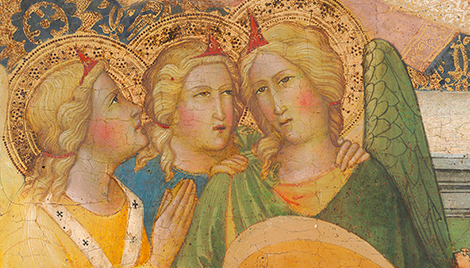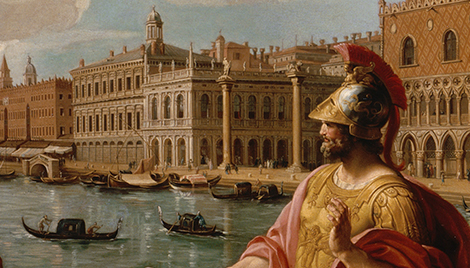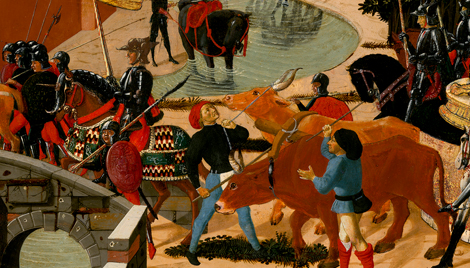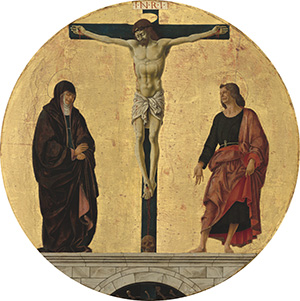The Crucifixion
The Crucifixion
- Artist
- Francesco del Cossa
- Artist Dates
- c. 1436-1477/1478
- Artist Nationality
- Italian
- Title
- The Crucifixion
- Date
- c. 1473/1474
- Medium
- tempera on poplar panel
- Dimensions
- diameter of painted surface: 60 x 63.2 cm 23 5/8 x 24 7/8 in
- K Number
- K1361
- Repository
- National Gallery of Art
- Accession Number
- 1952.5.5
- Notes
Provenance
Comissioned c. 1473 by Floriano Griffoni for a family chapel (the sixth off the north aisle) in the church of San Petronio, Bologna; [1] moved to the Casa Aldrovandi, Bologna, c. 1731, but no longer there in 1782. [2] Possibly Giovanni Costabili, Ferrara, by 1872. [3] Philip Lehman [1861-1947], New York, by 1914; sold June 1943 to the Samuel H. Kress Foundation, New York; [4] gift 1952 to NGA. [1] The first mention of the altarpiece is in Giorgio Vasari's _Vite_. "Lorenzo Cossa" (a conflation of Cossa and Lorenzo Costa), in the 1550 life of Cossa's student Ercole de' Roberti ("Ercole Ferrarese", Vasari, ed. Rosanna Bettarini and Paola Barocchi, 8+ vols., Florence, 1966-: 3,part 1[1971]: 420), notes "E cosi in San Petronio, in una cappella, una tavola a tempera che si conosce a la maniera, con una predella sotto di figure piccole fatte con gran diligenzia" ("And likewise [he painted] in San Petronio, in a chapel, an altarpiece in tempera recognizale by its style, with a predella beneath of small figures done with great diligence"). In the 1568 edition of the _Lives_ (ed. Bettarini and Barocchi, 3, part 1, 1971: 419-420), Vasari provides further information, noting that the chapel was dedicated to Saint Vincent and that the predella, which Vasari considered of higher quality than the rest of the altarpiece, was painted by Ercole. The 1568 edition includes a separate biography for "Lorenzo Costa" (the same Cossa-Costa conflation with a slightly different name) mentioning the chapel's donors, the Griffoni (Vasari, ed. Bettarini and Barocchi, 3, part 1, 1971: 415-416). That the Griffoni patron of the altarpiece was Floriano is demonstrated by a document of 19 July 1473 (_Archivio di San Petronio, Vacchetta di mandati_, VII, n. 413, c. 13t), cited by I.B. Supino, _L'arte nelle chiese di Bologna: secoli XV-XVI_, 2 vols., Bologna, 1932 and 1938: 2:196-199: "Item, m. Augustino de Marchi de Crema, magistro lignaminis, libras sex quatrinorum pro capsa quam fecit circa tablum altaris Floriani de Grifonibus; promiserunt Officiales ei donare." ("Item, the officials promised to give to Messr. Agostino de Marchi of Crema, master woodworker, six lire, for the frame which he made around Floriano Griffoni's altarpiece"). It was customary for an artist to undertake a large-scale painting after its frame had been made, so work on the altarpiece probably began after the woodcarver received payment for the frame. The attribution to Lorenzo Costa and association with Griffoni are also found in Pietro Lamo, _Graticola di Bologna, ossia descrizione delle pitture sculture e architteture di detta citta [c. 1560]_, Bologna, 1844: 39; Carlo Cesare Malvasia, _Pitture di Bologna_, Bologna, 1686: 242; Antonio di Paolo Masini, _Bologna perlustrata_, Bologna, 1666, 111, and _Pitture di Bologna_ (anonymous revision of Malvasia 1686), Bologna, 1706: 259. [2] On 14 February 1725 the painter Stefano Orlandi wrote to Cardinal Pompeo Aldrovandi, to whom custody of the Griffoni chapel had passed (Daniele Benati, 1984, 193 note 26, and "Per la recomposizione del polittico Griffoni," in _Da Borso a Cesare d'Este: La scuola di Ferrara, 1450-1628_, [exh. cat., Matthiesen Fine Art, Ltd., London], Ferrara, 1985: 172-174), "Dal sig. Dottore Galimberti mi viene signigicato che vostra Signoria Illustrissima e Reverendissima sia per fare dipingere nella sua capella in San Petrino l'ornamento del altare...per ciò ò stimato bene presentarli un piccolo abozo della forma che si ritrova la tavola di detta altare a ciò veda, che per fare un ornamento moderno, quello non potria servire in nisuna forma..." ("from Dr. Galimberti I understand that Your Reverence wishes to have decoration for the altar of your chapel in San Petronio painted...thus I have thought well to present to you a small sketch of the altarpiece so that you will see that it will not serve in any form to make modern ornamentation"). Orlandi's suggestion to remove the altarpiece seems to have been carried out shortly before 22 October 1731, when Aldrovandi was sent a letter from his agent Angelo Fontana (Benati, see above), which reads in part "In ordine poi al dipinto, che stava all'Altare nella Cappella in S. Petronio non mancarò d'abboccarmi col Sig. Maccaferri per ridurre quello in tanti quadretti nella miglior forma, che si potrà, supponendo voglia farli ornare concornici proprie per campagna..." ("As for the painting that was on the altar in the chapel in S. Petronio, I won't fail to speak with Sig. Maccaferri about reducing it into so many small pieces in the best possible shape, supposing a desire to ornament them with frames appropriate for the countryside..."). The Griffoni altarpiece was no longer included in the _Pitture di Bologna_ of 1732. The 1776 edition of _Pitture, scolture ed architetture...di Bologna..._, 215, notes decoration by Orlandi and Vittorio Bigari in the chapel ("Cospi, non più Griffoni") and continues: "La Tavola del Costa, colle storiette d'Ercole da Ferrara notate dal Vasari furono trasportate in Casa Aldrovandi allorchè il Cardinal Pompeo Aldrovandi successore de' Griffoni fece ridurre questa Cappella come al presente, prima di cambiarla colla Casa Cospi..." ("Costa's [sic] altarpiece, along with the little stories by Ercole of Ferrara noted by Vasari, were transported to the Casa Aldrovandi when Cardinal Pompeo Aldrovandi, successor of the Griffoni, had the chapel reduced to its present form, before exchanging it with the Cospi family"). An inventory of the Casa Aldrovandi in 1782 (Ms. B104, Biblioteca dell'Archiginnasio, Bologna) does not include any pictures that could come from the Griffoni altarpiece, however. [3] Robert Lehman, _The Philip Lehman Collection, New York: Paintings_, Paris, 1928: no. 80, indicates that the tondo comes from the Costabili collection in Ferrara. No _Crucifixion_ fitting this description is found in the collection of Count Giovanni Battista Costabili in 1838 (see Camillo Laderchi, _Descrizione della quadreria Costabili_, Ferrara, 1838-1841), but the sales catalogue of the collection of his nephew Giovanni Costabilli (Ferrara, 1872) lists a tondo with gold background ascribed to Lorenzo Costa, which could in fact be this painting, given the murky nineteenth-century knowledge of Ferrarese artists. [4] Joseph Breck, "A _Crucifixion_ by Francesco del Cossa," _Art in America_ 2 (June 1914): 314-317, describes the painting as having "...recently been acquired by Mr. Philip Lehman of New York..." Philip apparently gave the painting to his son Robert [1892-1969], who worked closely with his father in acquiring paintings for the collection, and who became a collector in his own right. A bill of sale between Robert Lehman and the Kress Foundation for fifteen paintings, including _The Crucifixion_, dated 11 June 1943 (payment was made four days later; copy in NGA curatorial files), indicates that he was the owner of the paintings.






